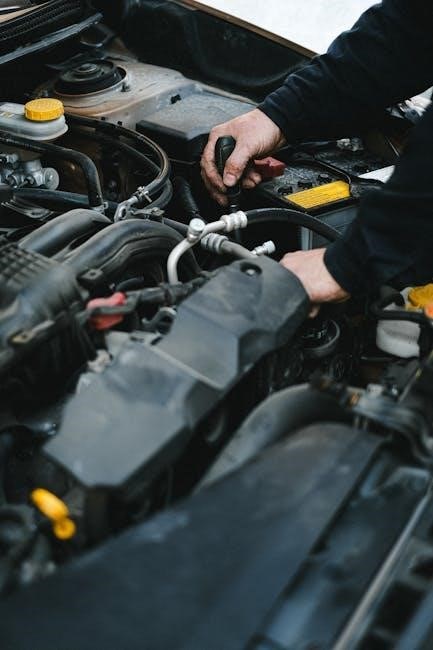Yale forklifts are renowned for their durability and reliability, offering a wide range of models to suit various industrial needs. Their parts manuals are essential for maintenance and optimal performance.
1.1 Brief History of Yale Forklifts
Yale Forklifts, a division of Yale Materials Handling Corporation, has a rich history dating back to 1844 when Frank Yale founded the company. Initially known for producing locks, Yale expanded into material handling equipment in the early 20th century. The company introduced its first electric truck in 1920, marking a significant milestone in industrial lifting solutions. Over the decades, Yale became synonymous with innovation, durability, and reliability in the forklift industry.
Post-World War II, Yale shifted focus to manufacturing forklifts, catering to the growing demand for industrial machinery. Today, Yale is a global leader with facilities worldwide, offering a diverse range of forklift models designed for various industrial applications. Their commitment to quality and innovation has solidified their reputation as a trusted brand in material handling.

1.2 Popular Yale Forklift Models
Yale offers a diverse range of forklift models designed to meet various industrial needs. Among the most popular are the ERC Series, known for their electric rider trucks and maneuverability in tight spaces, and the GDP Series, which features gas-powered engines ideal for heavy-duty outdoor applications. Additionally, the MO Series stands out as versatile electric counterbalanced forklifts, suitable for both indoor and outdoor operations.
These models are favored for their reliability, durability, and advanced ergonomic designs, making them indispensable in warehouses and manufacturing facilities worldwide. The demand for their parts manuals reflects their widespread use, ensuring operators can maintain peak performance and address repairs efficiently.
1.3 Importance of Yale Forklift Parts Manuals
Yale forklift parts manuals are indispensable for ensuring proper maintenance, troubleshooting, and repair of these industrial machines. They provide detailed diagrams, part numbers, and step-by-step instructions, enabling operators and technicians to identify and replace components efficiently. This resource is crucial for maintaining peak performance and extending the lifespan of Yale forklifts.
These manuals also play a key role in safety and compliance. By following the guidelines outlined, users can adhere to manufacturer recommendations, reducing the risk of accidents and ensuring operational compliance with industry standards. Additionally, having access to a parts manual can prevent costly downtime by allowing for quick identification and resolution of issues, making it an essential tool for any Yale forklift owner or operator.

Why You Need a Yale Forklift Parts Manual
A Yale forklift parts manual is essential for maintaining, repairing, and troubleshooting your equipment. It provides detailed diagrams, part numbers, and instructions, ensuring proper maintenance and safety compliance.
2;1 DIY Repairs and Maintenance
Having a Yale forklift parts manual is invaluable for DIY repairs and maintenance. It provides step-by-step instructions and diagrams, allowing you to identify and replace parts efficiently. Whether troubleshooting common issues or performing routine checks, the manual ensures you can handle tasks independently. By following the guide, you can address problems like hydraulic leaks or electrical faults without professional assistance. This not only saves time but also reduces costs. Additionally, the manual helps you understand safety protocols and maintenance schedules, ensuring your forklift operates optimally. With clear instructions and detailed part lists, you can confidently tackle repairs, extending your equipment’s lifespan. Accessing the manual as a free PDF makes it easier to keep it handy for quick reference. Overall, it empowers you to maintain your Yale forklift effectively, reducing downtime and improving productivity.
2.2 Cost Savings Through Proper Maintenance
A Yale forklift parts manual is crucial for achieving cost savings through proper maintenance. By following the manual’s guidelines, you can extend the lifespan of your equipment, reduce repair costs, and minimize downtime. Regular maintenance ensures that small issues are addressed before they escalate into major, costly problems. The manual provides detailed schedules and procedures, helping you stay on track with routine checks and replacements. This proactive approach prevents unexpected breakdowns, which can be expensive and disrupt operations. Additionally, understanding how to perform maintenance correctly reduces the risk of premature wear and tear, saving you money on spare parts. By optimizing your forklift’s performance, you also lower operational costs over time. Accessing the manual for free as a PDF ensures you have constant access to these cost-saving strategies, making it an essential resource for managing your fleet efficiently.
2.3 Compliance with Safety Regulations
A Yale forklift parts manual is essential for ensuring compliance with safety regulations. By following the manual’s guidelines, you can adhere to industry standards and maintain a safe working environment. Regular maintenance, as outlined in the manual, helps prevent accidents and ensures your equipment operates safely. The manual provides detailed safety protocols and inspection checklists, which are crucial for meeting OSHA and other regulatory requirements. Proper adherence to these guidelines reduces the risk of workplace injuries and legal liabilities. Additionally, the manual ensures that all safety features are functioning correctly, protecting both operators and bystanders. By referencing the manual, you can stay informed about best practices for forklift operation and maintenance, ensuring your fleet remains compliant and safe. This makes the Yale forklift parts manual an indispensable tool for promoting workplace safety and regulatory adherence.

Where to Find Yale Forklift Parts Manual PDF Free
Yale forklift parts manuals can be found on Yale’s official website, trusted third-party platforms like ManualsLib, and various industrial equipment forums. Ensure safe and reliable downloads.
3.1 Official Yale Website Resources
The official Yale website provides a comprehensive repository of resources, including parts manuals for various forklift models. Users can access these materials by navigating to the support or downloads section, where they can search by model number or equipment type. The manuals are typically available in PDF format, ensuring easy access and compatibility across devices. Yale’s website is a reliable source, offering accurate and up-to-date information. Additionally, the site may require users to create an account or provide basic information to access certain documents, ensuring that the materials are used appropriately. By utilizing Yale’s official resources, users can ensure they are getting genuine and trustworthy manuals, which is crucial for maintaining their equipment effectively.
3.2 Third-Party Websites for Manuals
Beyond the official Yale website, third-party platforms offer free access to Yale forklift parts manuals in PDF format. Websites like ManualsLib.com provide an extensive library of user manuals for various equipment, including Yale forklifts. These platforms are particularly useful for users who may not have access to the official Yale website or prefer alternative sources. Additionally, some forums and industrial equipment communities share manuals uploaded by other users. While these resources can be convenient, it’s important to verify the authenticity and accuracy of the documents to ensure they match your specific model. Always exercise caution when downloading from third-party sites to avoid malware or outdated information. Using reputable platforms and cross-referencing the content with official sources can help maintain safety and reliability.
3.3 Tips for Downloading PDF Manuals Safely
When downloading Yale forklift parts manuals from the internet, ensure you prioritize safety to avoid malware or phishing risks. Stick to reputable websites like ManualsLib.com or official Yale resources, as they are less likely to host malicious content. Avoid downloading from unfamiliar or unsecured sites, as they may compromise your device’s security. Always verify the file type and size before downloading, as legitimate manuals are typically large PDF files. Additionally, use an antivirus program to scan the downloaded file before opening it. Be cautious of pop-up ads or multiple redirects, as these can be signs of unsafe sites. By following these precautions, you can safely obtain the necessary manual while protecting your digital environment. Remember, security should always be your top priority when accessing free resources online. This ensures both your personal and professional data remain safeguarded.

Understanding Your Yale Forklift Parts Manual
Your Yale forklift manual is a comprehensive guide containing detailed diagrams, parts lists, and maintenance instructions. It helps users identify components and perform repairs efficiently, ensuring optimal equipment performance.
4.1 Navigating the Manual Effectively
Navigating your Yale forklift parts manual requires a systematic approach. Start by reviewing the table of contents to locate specific sections, such as maintenance schedules or parts diagrams. Use the index to quickly find components or procedures. Pay attention to sections highlighted for routine maintenance, as these are crucial for extending the lifespan of your forklift. Familiarize yourself with common symbols and abbreviations used throughout the manual, as they provide essential information about parts and procedures. Digital versions of the manual, available as free PDF downloads, often include search functions that allow you to instantly locate keywords or specific parts. By understanding the manual’s structure, you can efficiently access the information needed to perform repairs, order replacement parts, and ensure compliance with safety standards.
4.2 Common Symbols and Abbreviations
Yale forklift parts manuals use specific symbols and abbreviations to convey critical information. For example, a gear icon often represents transmission components, while a battery symbol denotes electrical systems. Understanding these symbols is essential for accurate repairs and maintenance. Abbreviations like “LHS” (left-hand side) and “RHS” (right-hand side) help locate parts on the forklift. Digital manuals, available as free PDF downloads, may include a legend or key explaining these symbols. Familiarizing yourself with these visual cues ensures you can identify components quickly and follow instructions correctly. Pay attention to warning symbols, such as exclamation marks in triangles, which indicate safety precautions. By decoding these symbols and abbreviations, you can navigate the manual more efficiently and perform tasks safely and effectively.
4.3 Maintenance Schedules Overview
Yale forklift parts manuals provide detailed maintenance schedules to ensure optimal performance and longevity. These schedules outline recommended service intervals, such as daily, weekly, and monthly checks, to prevent breakdowns. Routine tasks include lubricating moving parts, inspecting hydraulic systems, and replacing worn components. The manual also specifies how often to check and replace filters, fluids, and tires. Adhering to these schedules helps maintain safety standards and reduces downtime. Digital versions of the manual, available as free PDF downloads, often include charts or tables for easy reference. By following the maintenance schedule, operators can identify potential issues early, reducing repair costs and extending the lifespan of the forklift. Regular maintenance also ensures compliance with workplace safety regulations, making it a critical part of forklift ownership and operation.

Maintenance and Troubleshooting
The Yale forklift parts manual is essential for routine maintenance and diagnosing issues. It provides guidance on inspections, repairs, and error code resolution, ensuring optimal performance and safety.

5.1 Common Issues and Solutions
Yale forklifts, like any machinery, may encounter common issues such as hydraulic leaks, battery malfunctions, or error codes. The parts manual provides detailed solutions for these problems, ensuring quick resolution. For instance, hydraulic leaks can often be traced to worn seals or damaged hoses, which the manual identifies for easy replacement. Battery issues may stem from improper charging or corrosion, both of which are addressed with step-by-step instructions. Error codes, such as those related to lift or traction faults, are decoded in the manual, guiding operators to specific components needing attention. By referencing the manual, users can diagnose and resolve these issues efficiently, minimizing downtime and maintaining productivity. Regular maintenance, as outlined in the manual, can also prevent many of these problems from arising in the first place.
5.2 Understanding Error Codes
Yale forklifts utilize error codes to indicate specific issues, which are essential for troubleshooting. The parts manual provides a comprehensive list of these codes, explaining their meanings and corresponding solutions. For example, error codes related to hydraulic systems or battery malfunctions are clearly defined, allowing operators to pinpoint the problem quickly. The manual also categorizes codes by severity, helping users determine whether immediate action is required or if the issue can be addressed during routine maintenance. By understanding these codes, operators can resolve problems efficiently, reducing downtime and ensuring safety. The manual further advises on how to clear codes after repairs, ensuring the forklift operates smoothly. This feature is invaluable for maintaining productivity and extending the lifespan of the equipment. Regularly reviewing the error code section in the manual helps users become familiar with common issues and their solutions, enhancing overall maintenance practices.
5.3 Preventative Maintenance Practices
Preventative maintenance is crucial for extending the lifespan and efficiency of Yale forklifts; Regular checks on fluid levels, tire condition, and battery health can prevent unexpected breakdowns. Operators should follow the maintenance schedule outlined in the parts manual, which provides detailed instructions for inspecting and replacing wear-and-tear components. Lubricating moving parts and ensuring proper hydraulic function are also key. The manual emphasizes the importance of using genuine Yale parts for replacements to maintain performance and safety standards. Additionally, operators should be trained to recognize early signs of potential issues, such as unusual noises or performance changes, and address them promptly. By adhering to these practices, businesses can reduce downtime, lower repair costs, and ensure compliance with safety regulations. The Yale Forklift Codes ebook and resources like ManualsLib further support these efforts by offering troubleshooting guides and maintenance tips. Consistent preventative care ensures optimal productivity and safety in industrial operations.

Safety Considerations
Safety is paramount when operating Yale forklifts. Ensure pre-operation checks, proper training, and adherence to safety protocols. Regular maintenance and emergency preparedness are vital for accident prevention.
6.1 Pre-Operation Safety Checks
Pre-operation safety checks are crucial for ensuring the safe and efficient operation of Yale forklifts. These checks help identify potential issues before they escalate, reducing the risk of accidents and downtime. Operators should inspect tires, brakes, lights, and hydraulic systems for damage or wear. Additionally, fluid levels, battery status, and mast alignment should be verified; The forklift’s load capacity and stability should also be checked to ensure safe operation. Referencing the Yale forklift parts manual provides detailed guidance on these inspections. Proper training and adherence to safety protocols are essential for operators to perform these checks effectively. Regular pre-operation checks not only enhance safety but also contribute to compliance with workplace safety regulations and standards.
- Inspect tires and brakes for wear or damage.
- Ensure all lights and hydraulic systems are functioning properly.
- Check fluid levels and battery status.
- Verify mast alignment and load capacity.
By following these steps, operators can ensure a safe working environment and prevent potential hazards.
6.2 Safe Lifting and Operating Practices
Safe lifting and operating practices are essential for preventing accidents and ensuring efficient forklift operation. Operators should always follow the guidelines outlined in the Yale forklift parts manual. Before lifting, ensure the load is stable and properly secured. The forks should be positioned correctly under the load, and the mast should be vertical. Operators must maintain clear visibility and avoid overloading the forklift beyond its rated capacity. Smooth, gradual movements are crucial to prevent tipping or losing control. Proper training and adherence to safety protocols are vital for operators to handle the forklift safely. Regular practice and review of the manual can enhance operator confidence and competence. By following these practices, operators can minimize risks and ensure a safe working environment.
- Ensure the load is stable and properly secured;
- Position forks correctly under the load.
- Maintain clear visibility during operation.
- Avoid overloading the forklift.
Adhering to these practices promotes safety and operational efficiency.
6.3 Emergency Procedures
Emergency procedures are critical to ensure operator and workplace safety in case of accidents or system failures. Always remain calm and follow the steps outlined in the Yale forklift parts manual. If a forklift malfunctions, immediately shut it down and engage the brakes. Evacuate the area and notify nearby personnel to prevent further incidents. In case of a collision or tip-over, exit the forklift carefully and seek assistance. For electrical or hydraulic failures, avoid attempting repairs without proper training. Contact emergency services if there are injuries or significant damage. Refer to the manual for specific emergency protocols tailored to your Yale forklift model. Regular training and familiarity with these procedures can prevent escalation of emergencies. Always prioritize safety and follow established guidelines to minimize risks.
- Shut down the forklift and engage the brakes.
- Evacuate the area and alert others.
- Avoid untrained repairs.
- Contact emergency services if needed.
Preparedness is key to handling emergencies effectively.

Identifying and Ordering Replacement Parts
Use the Yale forklift parts manual to identify components by model number or description. Order replacement parts from reliable suppliers or online retailers for efficient and accurate service.
7.1 Identifying Parts from the Manual
The Yale forklift parts manual is a comprehensive guide for identifying components. It includes detailed diagrams, part numbers, and descriptions, making it easier to locate specific parts. Users can refer to the manual’s index or search by model number to find relevant sections. Each part is typically illustrated in an exploded diagram, showing its position and relationship to other components. This visual representation helps in accurately identifying what needs replacement. Additionally, the manual provides a list of part numbers corresponding to each component, which can be cross-referenced when ordering. By following the manual’s instructions, users can ensure they identify the correct parts, avoiding errors and saving time. This step is essential for effective maintenance and repairs, as incorrect part identification can lead to further issues or compatibility problems.
7.2 Reliable Suppliers for Yale Parts
When searching for Yale forklift parts, it’s crucial to rely on trusted suppliers to ensure quality and compatibility. The official Yale website offers a dedicated section for parts and accessories, guaranteeing authenticity. Authorized Yale dealers are another excellent source, providing genuine components and expert advice. Additionally, websites like ManualsLib.com and third-party suppliers specialize in offering manuals and parts for various Yale models. These platforms often have extensive catalogs and user-friendly search options. Always verify the credibility of suppliers by checking reviews and ratings to avoid counterfeit parts. Reliable suppliers not only provide durable components but also ensure compliance with safety standards, which is vital for maintaining your forklift’s performance and longevity. By purchasing from reputable sources, you can trust that the parts will meet your specific needs and uphold the quality expected from Yale equipment.
7.3 Tips for Ordering Parts Online
When ordering Yale forklift parts online, ensure accuracy by using the exact part numbers from your manual. Verify the supplier’s credibility through reviews and ratings to avoid counterfeit items. Always check for SSL encryption on the website to secure your transactions. Compare prices across trusted platforms to find the best value without compromising quality. Read product descriptions carefully to confirm compatibility with your specific Yale model. Look for clear return and refund policies in case of errors or mismatches. Additionally, consider websites like ManualsLib.com, which offers free access to manuals and parts information, aiding in precise ordering. Communication with customer service can resolve uncertainties, ensuring your order meets your needs. Prioritizing these steps guarantees a smooth and reliable online purchasing experience for Yale forklift parts.

DIY Repair vs. Professional Service
Yale forklift manuals empower users to perform DIY repairs, but complex issues may require professional expertise. Manuals like the Yale Forklift Codes ebook provide essential troubleshooting guidance for both scenarios.
8.1 Pros and Cons of DIY Repairs
DIY repairs for Yale forklifts can save time and money, especially with a comprehensive parts manual like the Yale Forklift Codes ebook. This approach allows operators to address minor issues promptly, enhancing productivity. However, DIY repairs also carry risks, such as incorrect part replacements or improper procedures, which may lead to safety hazards or further damage. Additionally, without proper expertise, complex problems might worsen, requiring costly professional interventions later. Therefore, while DIY repairs are empowering, they demand careful adherence to manual instructions and an honest assessment of one’s technical skills. Always prioritize safety and consider professional assistance for critical or unfamiliar tasks. The Yale Forklift Codes ebook provides valuable troubleshooting guidance, making DIY repairs more manageable for knowledgeable users.
- Pros: Cost savings, convenience, and empowerment through detailed manuals.
- Cons: Potential for errors, safety risks, and long-term damage if mishandled.
8.2 When to Call a Professional
While DIY repairs can be cost-effective for minor issues, certain situations demand professional expertise. Complex mechanical or electrical problems, such as faulty hydraulic systems or error code diagnostics, often require specialized tools and knowledge. Additionally, if the repair involves critical safety components or compliance with regulatory standards, consulting a certified technician is essential to ensure adherence to safety protocols. Operators who lack confidence in their technical skills or are uncertain about procedures should also seek professional assistance. Furthermore, for high-value equipment like Yale forklifts, improper repairs could lead to costly downtime or even void warranties. A professional service guarantees quality workmanship and peace of mind, ensuring your forklift operates safely and efficiently. Always refer to the Yale Forklift Codes ebook or reliable suppliers for trusted service recommendations.
- Complex repairs requiring specialized tools or knowledge.
- Safety-critical issues or regulatory compliance concerns.
- Lack of confidence in DIY repair capabilities.



